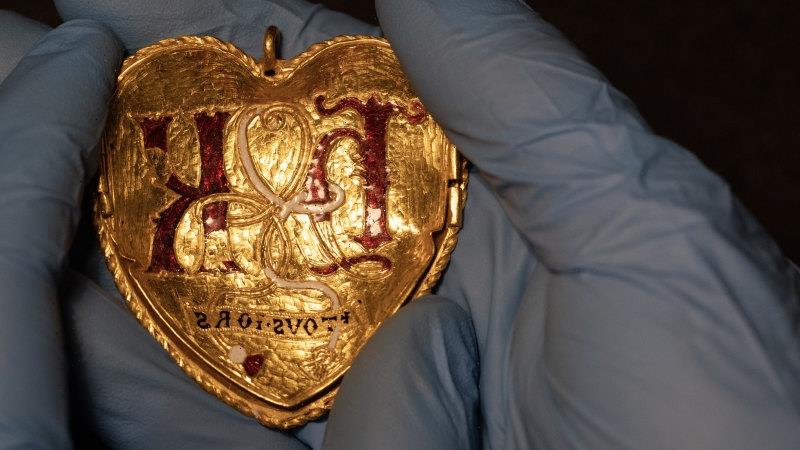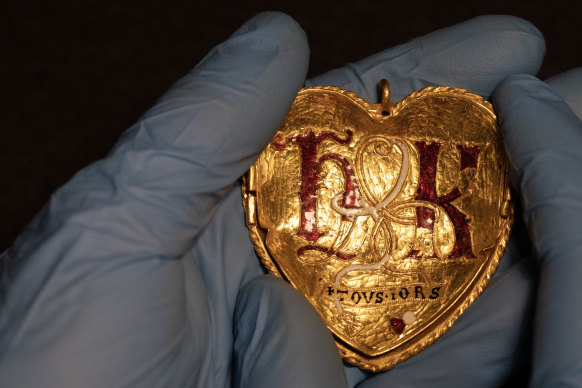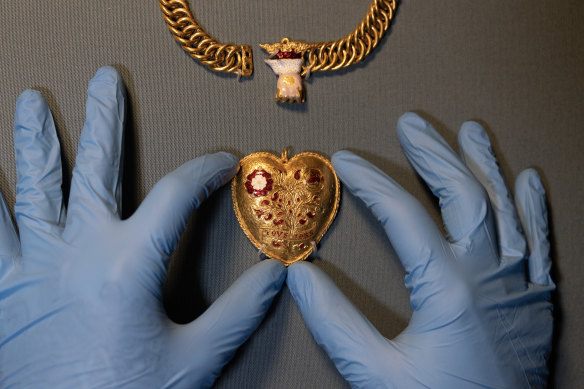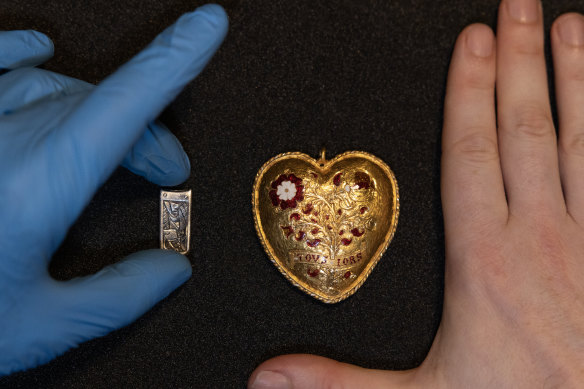London: Charlie Clarke, a 34-year-old cafe owner in Birmingham, England, was feeling down about losing his dog to cancer, so he went over to a friend’s place in the countryside to take a stroll and get some fresh air. He brought his metal detector with him, gear for the new hobby he had picked up six months earlier.
When he heard the unusually loud beeps emitted while he walked on his friend’s property in nearby Warwickshire, he thought he had probably come across a soda can. Instead, about a foot (30 cms) down into the earth, he happened upon a treasure that has electrified researchers and could very well change the course of his family’s future.
A chain with a pendant, associated with Henry VIII and his first wife, Katherine of Aragon. The heart shaped pendant was found by a metal detectorist in Warwickshire. Credit:Getty
Clarke pulled up a gold chain and heart-shaped pendant, adorned with symbols his friend recognised as connected to Henry VIII and his first wife, Katherine of Aragon. At first, he thought it must have been from a costume, but it seemed far too heavy for that, he said in an interview Friday.
“I knew it was special,” he said.
The pendant itself was an ornate spectacle: The front was decorated with a pomegranate bush, an emblem of Katherine, and an entwined, double-headed Tudor rose, which was employed by the Tudors starting in 1486. On the other side, the letters H and K — for Henry and Katherine — were written in Lombardic script and connected by a ribbon.
There hasn’t been anything comparable dating from the Renaissance era found in the past 100 years, said one expert.Credit:Getty
By law, those who find treasure in Britain are required to report their finds, allowing museums the chance to acquire them, paying a fee that is split evenly between the finder and the landowner. After finding the pendant, in 2019, Clarke first brought it to an expert in Birmingham, who he recalled was “shaking when she held it, her jaw was on the floor”.
It was then sent to the British Museum, where researchers were similarly agog.
“We all thought: My goodness, is this for real? Could this possibly be?” Rachel King, curator of Renaissance Europe for the British Museum, said in an interview on Friday.
Researchers have confirmed the pendant’s authenticity, placing it at about 500 years old, but those who have examined it are left to speculate on the story behind it. It appeared to be hastily crafted, seemingly built more to be seen than to endure, King said. The chain is small, suggesting that someone of a slight stature was meant to wear it.
The chain with a pendant is linked with King Henry VIII and his first wife, Katherine of Aragon and a silver strap-end depicting a bird-like animal, dating back to the 14th century. Both objects were found by metal detectorists.Credit:Getty
King said there were no portraits from the period showing men or women wearing jewels of the type, but one thing was for certain: Henry VIII loved to party. One hypothesis holds that it was created for a banquet or as a prize for a jousting tournament; winners could have worn it or melted it down for the gold, she said.
No one knows how it might have ended up in the field in Warwickshire; it could have been buried by someone trying to protect it, or perhaps by a thief trying to hide their loot, she said.
But King said the pendant was the most significant find in the 25 years since the government began recording British treasure finds, and there hasn’t been anything comparable dating from the Renaissance era found in the past 100 years, she said. She also said that most items connected to Katherine had been destroyed, and that there was “very, very little that keeps her memory alive”.
When the item is eventually sold, likely for a hefty fee, the money will be split between Clarke and his friend, the landowner. Clarke said that the money could be life-changing for him and his 4-year-old son.
“Birmingham’s a pretty rough place, right where I’m from,” he said. “If I could get him some good education out of this, that’s the benefit of it all.”
This article originally appeared in The New York Times.
Get a note directly from our foreign correspondents on what’s making headlines around the world. Sign up for the weekly What in the World newsletter here.
Most Viewed in World
From our partners
Source: Read Full Article



